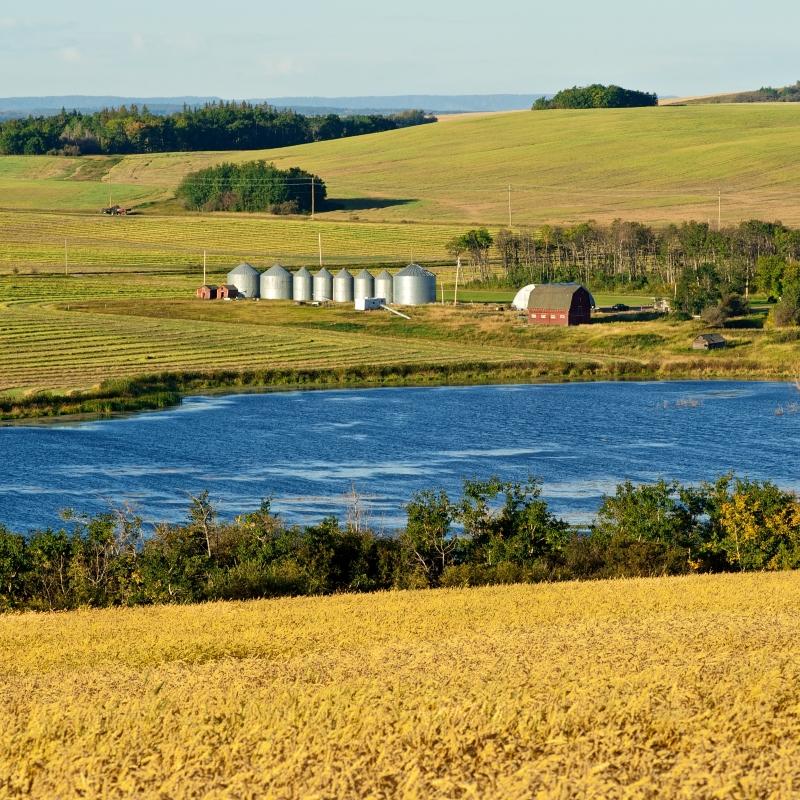Section 3.3
Effects of Agriculture and Climate Change on Prairie Wetlands
Exploring genomics tools to understand the effects of agriculture and climate change on prairie wetland biodiversity.


 Rob Hinchliffe
Rob Hinchliffe
This Coleoptera larva is one of the aquatic macroinvertebrates being used as an indicator of wetland health and productivity.
The Alberta Biodiversity Monitoring Institute (ABMI), InnoTech Alberta, and Ducks Unlimited Canada have partnered on a four-year project to better understand linkages between wetland health and waterfowl breeding success in the face of agricultural land use and climate change. We are sampling a range of parameters, including:
- Wetland water quality measured across a gradient of agricultural land cover and wetland permanence types.
- Aquatic macroinvertebrates—an indicator of wetland productivity and health—sampled using conventional approaches and genomics (genetics-based) methods to determine community composition and relative abundance.
- Waterfowl productivity assessed by counting the number of waterfowl pairs and broods (i.e., ducklings) on wetlands, and waterfowl predators detected using autonomous recording units (ARUs) and remote cameras.
In this section, we provide an overview of this four-year project and summarize highlights from the first year.
Introduction
- Much of southern Alberta is part of the Prairie Pothole Region of Canada, named for the millions of small—yet ecologically significant—depressional wetlands scattered across the region.
- These biodiversity hot spots provide invaluable ecosystem services (e.g., water supply and storage, wildlife habitat), but have been significantly affected or lost due to land use pressures (primarily agriculture) in the recent past.
- Climate change is predicted to exacerbate these pressures in a number of ways. For example, smaller wetlands are expected to dry out more frequently, making them more vulnerable to conversion to other land uses and decreasing habitat and connectivity for wildlife. Further, a warmer climate is expected to reduce the number of days a wetland has standing water, and to increase the variability in this hydroperiod; this could lead to biodiversity and productivity losses.
- To address these issues, the ABMI, InnoTech Alberta, and Ducks Unlimited Canada have partnered to investigate the impacts of agricultural land use and climate change on wetland health using innovative genomics (i.e., genetic based) methods.

The Prairie Pothole Region provides the most productive waterfowl breeding habitat in North America.

Many of the wetlands in the Prairie Pothole Region have been converted to agriculture or affected by agricultural practices and agrochemicals.
In this section, we provide an overview of this four-year project, which uses aquatic invertebrates, wetland water quality, and waterfowl productivity as indicators of wetland health, discuss the application of environmental genomics to investigate ecological questions, highlight results from the first year and present next steps.
About this project
Effects of Agriculture and Climate Change on Prairie Wetlands
The ABMI is collecting aquatic macroinvertebrates, which are sensitive to the stresses associated with agricultural land use and climate change (e.g., agrochemicals, shortened hydroperiod), making them excellent indicators of wetland health. They are also a key source of food for waterfowl, which are being studied by Ducks Unlimited Canada as part of this project.
Conventional methods for gathering and analyzing macroinvertebrate data are limited in their ability to explain the complex relationships between wetland health and ecological pressures[1]. Hence, this project is exploring newer, cost-effective genomics methods to investigate these connections; genomics analyses will be run at InnoTech Alberta’s labs.
Phase 1 (years 1 and 2) of this project is focused on evaluating environmental genomics tools for determining community composition and relative abundance of aquatic macroinvertebrates and the species of wetland vegetation that provide their habitat.
Phase 2 (years 3 and 4) will focus on applying an optimized genomics approach to:
- examine the effect of hydroperiod, agricultural land cover, and water quality (including agrochemical presence and concentrations) on aquatic macroinvertebrate relative abundance/biomass and community structure, and related impacts to waterfowl;
- estimate the expected loss of invertebrate diversity and biomass production due to changes in wetland hydroperiod as a result of climate change;
- recommend best management practices associated with sustainable agriculture that promote healthy wetlands that support invertebrates and waterfowl; and,
- better understand the impacts of agricultural practices and climate change on wetland health.
Aquatic invertebrates are critical elements of food webs in all wetlands, and many species are sensitive to the stresses associated with land use and climate change, making them useful indicators of overall wetland ecological health.
 Rob Hinchliffe
Rob Hinchliffe
As one of the larger aquatic beetle larvae in Alberta's wetlands, Graphoderus liberus is near the top of the aquatic invertebrate food chain. Their presence indicates a diverse and healthy food base within the wetland.
 Rob Hinchliffe
Rob Hinchliffe
Most snails, such as this tadpole snail (Physella sp.), spend their time scraping the thin layer of algae from exposed surfaces. Their presence signifies an ecologically robust wetland with high primary productivity.
 Rob Hinchliffe
Rob Hinchliffe
After molting into an adult, this damselfly will disperse far from its natal wetland. The presence of top-level predators such as damselflies provides valuable information about the overall well-being of wetland ecosystems and the landscapes in which they are embedded.
Spotlight on wetland genomics
What’s all the buzz about environmental genomics?
Environmental genomics involves sequencing DNA from samples collected from the environment. These samples can be from different habitats (e.g., wetlands, forests), different media (e.g., water, soil, air), or directly from specimens such as aquatic invertebrates or plants.
Conventional methods for sampling and monitoring species groups—such as aquatic invertebrates—rely on morphological identification of individual specimens. In contrast, environmental genomics allows researchers to obtain significant information from DNA extracted from organisms or their environments, an approach which provides the following benefits:
- enhances speed and accuracy of species identification,
- reduces time required to process and identify sample organisms,
- increases taxonomic resolution by enabling the detection of cryptic or hard-to-identify species,
- captures information (from shed cells or immature or damaged specimens) that would not be obtainable through conventional methods, and,
- allows for the assessment of entire biological communities, aiding in the evaluation of ecosystem health and responses to environmental stressors on a larger scale.
How does it work?
Environmental DNA
- Environmental DNA (eDNA) analysis takes advantage of the fact that organisms shed cells into their environment as waste products, mucous, gametes, carcasses, etc. Shed cells contain DNA, which persists in the environment for a period of time before degrading.
- eDNA can be extracted from samples taken from the ecosystem, such as filtered water samples, and used as an indirect measure of organisms present in the ecosystem (e.g., a wetland).
Community DNA
- A related process, known as community DNA analysis, involves the collection of sample organisms or parts of organisms (e.g., tissue samples) that are dried, ground, and combined for DNA sequencing to directly identify the different species present within a sample.
Both eDNA and community DNA methods primarily offer presence/absence data for the species present in a sample. In this project we are using both of these environmental genomics techniques to examine species presence and community species richness for aquatic invertebrates and vegetation, but also to explore the feasibility of extracting relative biomass information as a proxy for relative abundance of the various invertebrate species.
First Year Results
Study Design
- We are employing a landscape-based approach using quarter sections as study sites, with approximately 10 to 15 wetlands sampled within each study site. Wetlands at each site span a range of permanence types, including semi-permanent and temporary wetlands, to capture potential alternative impacts resulting from climate change.
- In the prototype year, we collected samples of water, aquatic invertebrates and vegetation from wetlands in two quarter sections: one in a high cropland (e.g., canola) cover landscape with 12 wetlands and one in a low cropland (e.g., tame or natural grassland) cover landscape with 8 wetlands.

An example of a high cropland cover quarter section (not an actual study location)

We counted 39 breeding pairs and 52 ducklings at the low cropland site and 53 breeding pairs and 70 ducklings at the high cropland site
In the Field
- At each wetland, we collected aquatic invertebrate samples for conventional morphological identification and for community DNA analysis, water samples for eDNA analysis, aquatic vegetation to characterize aquatic macroinvertebrate habitat, and water quality information.
- Waterfowl predators were monitored at wetland and upland locations using both remote cameras and autonomous recording units (ARUs); data are being processed from 123,006 photos and approximately 117 hours of audio recordings in the first year of data collection.
- We sampled water quality (e.g., pH, dissolved oxygen) and agrochemicals (e.g., insecticides, herbicides, fungicides) on three occasions (May, June, July) at 20 wetland basins per occasion.
- 95 aquatic invertebrate samples have been sorted into 43,309 specimens, with 23,570 of them being target specimens identified to the lowest level possible (see Alberta Biodiversity Monitoring Institute 2015[2] for detailed methods).
- Following conventional taxonomic identification, aquatic invertebrate specimens from select target groups were dried, weighed, and recombined into DNA extraction tubes for community DNA analysis. Protocols for the extraction and sequencing of invertebrate community DNA (invertebrate) samples are being developed and tested at InnoTech Alberta.
- eDNA has been extracted from water samples, and DNA sequencing of these samples is underway.
- Samples of each wetland vascular plant that was collected and identified were sequenced to begin a DNA library to assist in future identifications in eDNA water samples.
- Agrochemical samples were analyzed for concentrations of 122 known chemical compounds.
- These data and analyses will be used to investigate the relationships between invertebrate species/communities and factors such as aquatic vegetation, agrochemicals, land cover, and water permanence at study wetlands.

Aquatic invertebrate samples are processed and dried at the ABMI labs...

...and DNA is extracted from the samples, amplified and analyzed in the lab at InnoTech Alberta.
Next Steps
- The project has made significant strides in developing and implementing field protocols, processing samples, and managing data flow.
- Building upon the foundation laid in the pilot season, the aim for Year 2 of the project is to refine techniques, expand data collection, and develop an optimized method for applying these techniques to characterizing aquatic macroinvertebrate and aquatic vegetation community composition and relative abundance. In Years 3 and 4, these optimized methods will be used across a larger sample of Alberta wetlands.
- In upcoming field seasons, our expanded sample size will include more wetlands of varying water permanence types, which will provide a proxy to test the impacts of climate change.
- Stay tuned for updates and more results…
 Rob Hinchliffe
Rob Hinchliffe
Submerged aquatic vegetation provides habitat for aquatic invertebrates—a key food source for waterfowl in the Prairie Pothole Region.
Project Delivery Partners
The collaborative efforts of the ABMI, InnoTech Alberta, and Ducks Unlimited Canada underscore the commitment to advancing knowledge and fostering sustainable agricultural practices while preserving the rich biodiversity of Alberta's wetland landscapes. Funding for this project has been generously provided by Ducks Unlimited Canada and the Alberta Innovates Water Innovation Program.




References
Bush, A, WA Monk, ZG Compson, DL Peters, TM Porter, S Shokralla, MTG Wright, M Hajibabaeig, and DJ Baird. 2019. DNA metabarcoding reveals metacommunity dynamics in a threatened boreal wetland wilderness. Proceedings of the National Academy of Sciences, 117(15):8539-8545.
Alberta Biodiversity Monitoring Institute. 2015. Processing aquatic invertebrates (10017), 2015-07-23. Alberta Biodiversity Monitoring Institute, Alberta, Canada. Report available at: https://abmi.ca/home/publications/351-400/396.
Project Team

Dr. Tyler Cobb, Director, Processing Centre, Alberta Biodiversity Monitoring Institute (ABMI): Project Co-lead
Tyler is a research associate and adjunct professor at the University of Alberta who has served as director of the ABMI’s Processing Centre since 2008. He manages a team of scientists responsible for the institute’s taxonomic research and delivering the ABMI’s plant, lichen and invertebrate datasets. An advocate for taxonomy with an aptitude for building lasting professional networks and developing strong scientific leaders, Tyler is recognized for his work in entomology, forest fire ecology, and species-level monitoring.
Contact: tyler.cobb@ualberta.ca

Dr. Matt Dyson, Research Scientist, Institute for Wetland and Waterfowl Research, Ducks Unlimited Canada: Project Co-lead
Matt is a research scientist in Ducks Unlimited Canada’s Institute for Wetland and Waterfowl Research who studies behavioural and demographic responses of waterfowl to landscape change. Matt’s research seeks to advance our understanding of ducks through the evaluation and testing of management assumptions for important breeding areas, including both prairie and boreal forest regions of Canada. Matt’s work also focuses on identifying research needs and designing studies to fill key knowledge gaps in scientific understanding of waterfowl ecology.
Contact: m_dyson@ducks.ca

Dr. Brian Eaton, Manager, Environmental Impacts, InnoTech Alberta: Project Co-lead
Brian is the manager of the Environmental Impacts Team at InnoTech Alberta, a group of scientists and technologists who develop and validate processes and technologies to enable more efficient, effective, and economical environmental monitoring and management in Alberta and beyond. Brian is an ecologist with research experience in terrestrial and aquatic systems, examining pure and applied questions across a wide array of taxa. He has 25+ years of experience in applied ecological research, including studies in oil and gas, forestry, and agricultural systems, and across a variety of experimental venues, from aquaria to large-scale mesocosms to purely field-based research, including wetlands, lakes, streams, rivers, and a variety of terrestrial habitats. Most recently, Brian and his colleagues have been exploring the use of environmental DNA to detect species—including fish, amphibians, semi-aquatic mammals, and invertebrates—in aquatic systems in Alberta.
Contact: brian.eaton@innotech.alberta

Robert Hinchliffe, Lead Scientist, Aquatic Invertebrates, Alberta Biodiversity Monitoring Institute (ABMI)
Rob has been involved with the ABMI since 2006. Starting out as an aquatics field crew member testing the prototype sampling protocols, he went on to lead ABMI aquatic field operations for the first two years of the program. As an aquatic invertebrate taxonomist, Rob currently leads the processing and identification of aquatic invertebrate samples and assists with data analysis.
Contact: robert.hinchliffe@ualberta.ca

Dr. Lysandra Pyle, Lead Scientist, Vascular Plants, Alberta Biodiversity Monitoring Institute (ABMI)
Lysandra has been formally working with the ABMI since 2022; initial work with the ABMI started in 2017 with short-term taxonomy and grassland support. Prior to joining the ABMI, Lysandra worked in the field of rangeland plant ecology research in western Canadian provinces and the United States. Lysandra leads the plant taxonomy elements of the project.
Contact: lysandra.pyle@ualberta.ca

Andrew Collard, Research Technician in Ducks Unlimited Canada’s Institute for Wetland and Waterfowl Research
Andrew joined the Institute for Wetland and Waterfowl Research (IWWR) at Ducks Unlimited Canada in March of 2023. He leads field work and coordinates logistics to safely collect sound data on wetland health and waterfowl productivity in the Prairie Pothole Region. In addition to this collaborative project, Andrew supports other IWWR programs. Andrew is based in Winnipeg, MB.
Contact: a_collard@ducks.ca

Susan Koziel, Senior Research Technologist, Molecular Genetics, BioIndustrial Services, Innotech Alberta
Susan has been with Alberta Innovates since 2000. Initially with the plant genetics group, she worked on soil, dust, and compost microbial studies, as well as genotyping bacteria, fungus, and plants. This work has expanded into environmental DNA studies and she is the technical expert in the molecular biology lab for environmental samples.
Contact: susan.koziel@innotechalberta.ca

Dr. Jori Harrison, Research Scientist, Molecular Ecology, Environmental Impacts, InnoTech Alberta
Jori is a research scientist with the Environmental Impacts Team at InnoTech Alberta; she has 10+ years of experience using molecular ecology techniques to improve applied environmental monitoring. Jori’s research focuses on improving our understanding of ecosystems through development and use of environmental DNA (eDNA) monitoring techniques and molecular-based biomarkers. She also has extensive experience in examining wildlife population dynamics using genetic techniques.
Contact: jori.harrison@innotechalberta.ca




